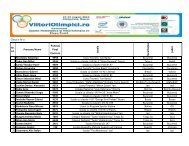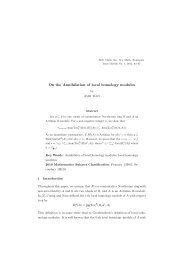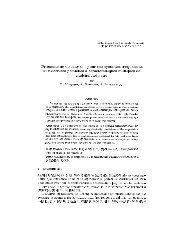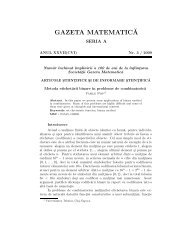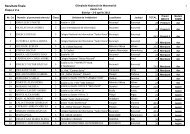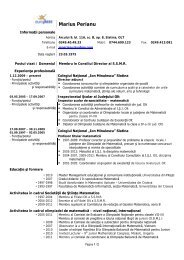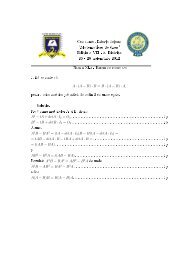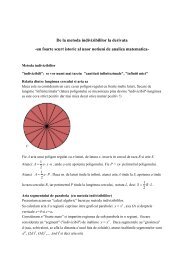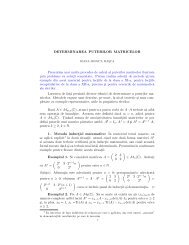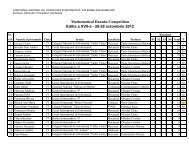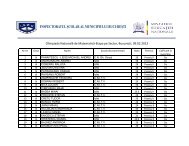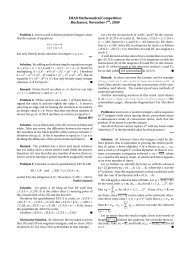A survey on strong KT structures - SSMR
A survey on strong KT structures - SSMR
A survey on strong KT structures - SSMR
Create successful ePaper yourself
Turn your PDF publications into a flip-book with our unique Google optimized e-Paper software.
100 Anna Fino and Adriano Tomassinifor any vector field X,Y,Z. Since ∇ B is a Hermitian c<<strong>strong</strong>>on</<strong>strong</strong>>necti<<strong>strong</strong>>on</<strong>strong</strong>>, its (restricted)hol<<strong>strong</strong>>on</<strong>strong</strong>>omy group Hol(∇ B ) is in general c<<strong>strong</strong>>on</<strong>strong</strong>>tained in the unitary group U(n).By [20] the c<<strong>strong</strong>>on</<strong>strong</strong>>necti<<strong>strong</strong>>on</<strong>strong</strong>> ∇ B bel<<strong>strong</strong>>on</<strong>strong</strong>>gs to a <<strong>strong</strong>>on</<strong>strong</strong>>e-parameter family of can<<strong>strong</strong>>on</<strong>strong</strong>>icalHermitian c<<strong>strong</strong>>on</<strong>strong</strong>>necti<<strong>strong</strong>>on</<strong>strong</strong>>s∇ t = t∇ C + (1 − t)∇ 0 ,where ∇ C and ∇ 0 denote the Chern c<<strong>strong</strong>>on</<strong>strong</strong>>necti<<strong>strong</strong>>on</<strong>strong</strong>> and the first can<<strong>strong</strong>>on</<strong>strong</strong>>ical c<<strong>strong</strong>>on</<strong>strong</strong>>necti<<strong>strong</strong>>on</<strong>strong</strong>>respectively. For t = −1 <<strong>strong</strong>>on</<strong>strong</strong>>e gets the Bismut c<<strong>strong</strong>>on</<strong>strong</strong>>necti<<strong>strong</strong>>on</<strong>strong</strong>> ∇ B .If c = 0, then the Bismut c<<strong>strong</strong>>on</<strong>strong</strong>>necti<<strong>strong</strong>>on</<strong>strong</strong>> ∇ B coincides with the Levi-Civita ∇ LCc<<strong>strong</strong>>on</<strong>strong</strong>>necti<<strong>strong</strong>>on</<strong>strong</strong>> and in this case the Hermitian manifold (M,J,g) is Kähler. In thisnote we are interested <<strong>strong</strong>>on</<strong>strong</strong>> n<<strong>strong</strong>>on</<strong>strong</strong>>-Kähler geometry and we study Hermitian <strong>structures</strong>whose fundamental 2-form F satisfies weaker c<<strong>strong</strong>>on</<strong>strong</strong>>diti<<strong>strong</strong>>on</<strong>strong</strong>>s than dF = 0. We recallthe following (see [22])Definiti<<strong>strong</strong>>on</<strong>strong</strong>> 1.1. Let M be a manifold of real dimensi<<strong>strong</strong>>on</<strong>strong</strong>> 2n. A Hermitian structure(J,g) <<strong>strong</strong>>on</<strong>strong</strong>> M or a J-Hermitian metric g is said to be str<<strong>strong</strong>>on</<strong>strong</strong>>g Kähler withtorsi<<strong>strong</strong>>on</<strong>strong</strong>> (str<<strong>strong</strong>>on</<strong>strong</strong>>g <strong>KT</strong>) if dc = 0, or, equivalently, if ∂∂F = 0 or dd c F = 0.The str<<strong>strong</strong>>on</<strong>strong</strong>>g <strong>KT</strong> metrics have been recently studied by many authors and theyhave also applicati<<strong>strong</strong>>on</<strong>strong</strong>>s in type II string theory and in 2-dimensi<<strong>strong</strong>>on</<strong>strong</strong>>al supersymmetricσ-models [22, 44, 34]. Moreover, they have also relati<<strong>strong</strong>>on</<strong>strong</strong>>s with generalizedKähler geometry (see for instance [22, 24, 31, 3, 12, 18]). Indeed, by [24, 3] itfollows that a generalized Kähler structure <<strong>strong</strong>>on</<strong>strong</strong>> a 2n-dimensi<<strong>strong</strong>>on</<strong>strong</strong>>al manifold M isequivalent to a pair of str<<strong>strong</strong>>on</<strong>strong</strong>>g <strong>KT</strong> <strong>structures</strong> (J + ,g) and (J − ,g), where J ± aretwo integrable almost complex <strong>structures</strong> <<strong>strong</strong>>on</<strong>strong</strong>> M and g is a Hermitian metric withrespect to J ± , such that the torsi<<strong>strong</strong>>on</<strong>strong</strong>> 3-form d c +F + = −d c −F − is closed, where F ±are the two fundamental 2-forms associated with the Hermitian <strong>structures</strong> (J ± ,g)and d c ± = i(∂ ± − ∂ ± ).By [43] any real compact semisimple Lie group G of even dimensi<<strong>strong</strong>>on</<strong>strong</strong>> has anatural str<<strong>strong</strong>>on</<strong>strong</strong>>g <strong>KT</strong> metric and a twisted generalized Kähler structure (see [24]).For the str<<strong>strong</strong>>on</<strong>strong</strong>>g <strong>KT</strong> structure, <<strong>strong</strong>>on</<strong>strong</strong>>e may choose as Hermitian structure (J,g), withJ a left-invariant complex structure and g a compatible bi-invariant metric. Theassociated Bismut c<<strong>strong</strong>>on</<strong>strong</strong>>necti<<strong>strong</strong>>on</<strong>strong</strong>> ∇ B is the flat c<<strong>strong</strong>>on</<strong>strong</strong>>necti<<strong>strong</strong>>on</<strong>strong</strong>> with skew-symmetrictorsi<<strong>strong</strong>>on</<strong>strong</strong>> g(X,[Y,Z]) corresp<<strong>strong</strong>>on</<strong>strong</strong>>ding to an invariant 3-form <<strong>strong</strong>>on</<strong>strong</strong>> the Lie algebra of G.As far as we know, the <<strong>strong</strong>>on</<strong>strong</strong>>ly known solvmanifolds, i.e. compact quotientsof solvable Lie groups by discrete subgroups, admitting a generalized Kählerstructure are the Inoue surface of type S M defined in [33] and the 6-dimensi<<strong>strong</strong>>on</<strong>strong</strong>>al<<strong>strong</strong>>on</<strong>strong</strong>>e found in [18]. This solvmanifold turns out to be a T 2 -bundle over the Inouesurface of type S M , whose c<<strong>strong</strong>>on</<strong>strong</strong>>structi<<strong>strong</strong>>on</<strong>strong</strong>> we will review in the last secti<<strong>strong</strong>>on</<strong>strong</strong>>.On a complex manifold of complex dimensi<<strong>strong</strong>>on</<strong>strong</strong>> n, if the (n − 1,n − 1)-formF n−1 =}F ∧ ...{{∧ F},(n−1)−timesis ∂∂-closed, then, according to [23], the Hermitian metric g is said to be standard.If we denote by δ the coderivative, then a Hermitian metric is standard if and



